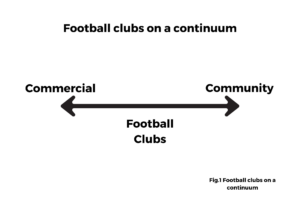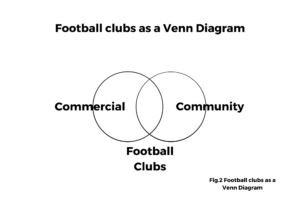In my other life as a university lecturer at UCFB Wembley recently, I was guest lecturing for a colleague, Darren Robinson on the Introduction to Sports Business module that I also teach two seminar groups on.
Like many of us at UCFB – particularly the big cohort of industry professionals like me who work in their expert field as well – Darren is fond of seeking contributions from others to help the students’ learning, bringing sessions to life, meaning they’re getting the latest insights and industry knowledge. Last week it was the University of Liverpool’s Kieran Maguire talking football finances, and this week I provided my thoughts on fan engagement, particularly in an industry preparing for the Independent Regulator.
In the introduction to my presentation, Darren outlined to the students how it appeared that in football there were two competing elements on a continuum (see fig.1 below). At one end the ‘commercial’: monetisation, marketing, the drivers to earn income to pay wages or even to drive the value of the club for a sale; at the other, ‘community’: fans (and fan engagement), rootedness, geographical location, meaning.

At some point in my presentation and subsequent discussion, I suggested that the real tension was down to football being in a state of denial or ignorance that these two areas are actually overlapping circles – a Venn Diagram (see fig.2 below).
Where I think Darren is correct is that contemporary football has tried to do is indeed to treat the commercial and community activity of clubs as being on a continuum, charting a course along that continuum as close to the commercial as it possibly can. It’s always trying to find the financial or monetary value first.
When a club tilts towards the community, it almost always does so in order to drive towards the commercial. That creates a real tension and consequently, decisions are largely informed by this tension. Clubs not paying a staff member (or enough staff members) to oversee just fan engagement in a business where fans are the principal stakeholder is an often repeated example (how often is it the already overburdened ticket office manager, or the head of marketing, or if you’re lucky, a hard-pressed volunteer?)

The point I would make is that clubs and football more widely are defying reality. I even liken it to defying gravity. These two elements are actually in co-existence, are interdependent, and behaving as though they are not contributes hugely and very negatively to the tension. If clubs would recognise this overlap, not only can they reduce the friction and the tension, they can also create the right kinds of commercial opportunities that balance the drive for value, income and all those related elements, with the need for and importance of, meaning, and the deeper stuff. As a consequence, all sorts of financial, sponsorship and monetising opportunities open up, whilst, yes, others close down (the proliferation of betting sponsorships might be a good example here).
The ‘community’ part is much more complex and interesting than simply a community or communities that provide the money or which is/are used to burnish the club’s image, brand or reputation in a one-dimensional way.
It might be that things really are as straightforward as I paint them, but it might even be that we can identify more than just the two overlapping circles in football’s Venn Diagram. What do you think? Drop us a line.